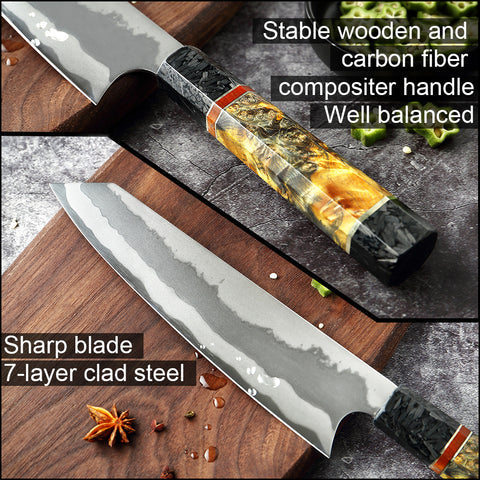Whether you’re a home cook or a professional chef, selecting the perfect handmade knife can dramatically enhance your culinary abilities while elevating your dishes to new heights. Handmade knives come in diverse styles and designs, each tailored for specific tasks in the kitchen. Whether it's chopping vegetables, slicing meat, or dicing onions, there's a handmade knife out there for every need. In this article, we'll delve deeper into the world of handmade knives, exploring their advantages, types, and how to choose the right one for your kitchen. Along the way, we’ll introduce two remarkable brands, SAKUTO and Okugai, whose creations are truly worth adding to any serious cook’s collection.
Take a moment to admire the craftsmanship in this stunning image:

### What Makes Handmade Knives Special?
One of the most striking features of handmade knives lies in their unparalleled quality and attention to detail. Unlike mass-produced knives, each handmade blade undergoes countless hours of labor-intensive work from highly skilled artisans. These craftspeople pour their expertise and passion into every piece, creating tools that are not only aesthetically pleasing but also exceptionally functional and durable.
### Crafting Techniques Behind Handmade Blades
Creating a handmade knife involves multiple stages, beginning with the forging process where raw steel is shaped. This is followed by meticulous grinding and heat treatment to ensure the blade achieves optimal hardness and flexibility. The finishing touches are equally important, where the blade is polished and sharpened to perfection. Materials like Damascus steel are often used due to their remarkable strength, allowing the knife to retain its sharpness even after extensive use.
### Benefits of Owning a Handmade Knife
#### Superior Sharpness and Edge Retention
Handmade knives are renowned for their sharpness and ability to hold an edge. Unlike machine-made knives, which tend to dull quickly, handmade knives maintain their cutting edge over time, providing precise cuts every time.
#### Ergonomic Comfort
The handles of handmade knives are designed with user comfort in mind. Their ergonomic shapes fit comfortably in the hand, reducing fatigue during long cooking sessions.
#### Aesthetic Appeal
Beyond functionality, handmade knives are works of art. Their intricate patterns and designs can transform any kitchen into a stylish space.
### Why Choose Japanese Damascus Steel Knives?
Among the many options available, Japanese Damascus steel knives stand out due to their exceptional quality and performance. By layering different metals together, these knives achieve a perfect balance of hardness and flexibility. This results in a razor-sharp edge that remains intact even after repeated use, while also resisting chipping or breaking.
### Key Considerations When Purchasing Handmade Knives
Before investing in a handmade knife, keep these points in mind:
1. **Purpose**: Determine what tasks the knife will perform. Different knives are designed for specific functions, such as chopping, slicing, or filleting.
2. **Material**: Opt for high-quality materials like Damascus steel, which offer both durability and performance.
3. **Design**: Choose a handle design that feels comfortable and secure in your hand. An ergonomic design minimizes fatigue and enhances control.
### Introducing Okugai Damascus Steel Kitchen Knife
For those seeking a touch of luxury and uniqueness, the Okugai Damascus Steel Kitchen Knife with an Abalone Handle is a top choice. The abalone handle not only adds elegance but also ensures a comfortable grip, making kitchen work a pleasure.
### Frequently Asked Questions
**What distinguishes handmade knives from mass-produced ones?**
Handmade knives are crafted by skilled artisans using premium materials and traditional techniques, resulting in sharper edges, greater longevity, and unmatched beauty. Mass-produced knives, on the other hand, are manufactured through automated processes with less attention to detail, leading to lower quality.
**How do I sharpen my handmade knife?**
To sharpen a handmade knife, use sharpening stones or honing rods. Start with a coarse grit stone to reshape the edge, then finish with a finer grit stone to polish and refine it. Maintaining a consistent angle throughout the process ensures the best results.
**Can handmade knives be used for all types of cooking?**
Yes, but it's essential to select the appropriate knife for the task. For instance, a chef’s knife is ideal for chopping and slicing, while a paring knife is better suited for detailed work.
**How should I store my handmade knives?**
Store them safely in knife blocks, magnetic strips, or protective sheaths to avoid damage and ensure safety. Avoid loose storage in drawers, as this can lead to dullness and pose risks.
**Are handmade knives worth the investment?**
Absolutely. Handmade knives represent a wise investment due to their superior performance over time, combined with their unique designs and craftsmanship, making them invaluable additions to any kitchen.
### Conclusion
In conclusion, handmade knives are more than just tools—they are investments in precision and beauty. Understanding the distinct features of each knife will help you make the right choice. So why wait? Consider acquiring a set like the SAKUTO Japanese Damascus Steel Kitchen Knife Set with a Blue Handle or the Okugai Damascus Steel Kitchen Knife with an Abalone Handle. Your cooking experience will never be the same again!
Dried Fish Chips,Snacks Dried Fish,Dry Fish Chips,Dried Fish Bulk
Yanji Yongzhen Food Co., Ltd , https://www.yanjiyongzhenfood.com